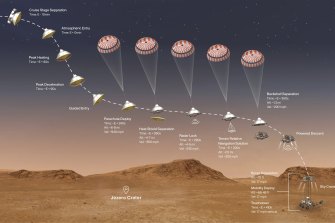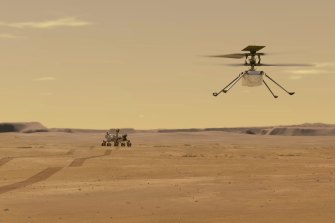
Rich in clays, the crater may have once contained liquid water. Along with searching for signs of previous life, Perseverance will prepare samples to be returned to Earth by future missions.
All things going well after its seven-month journey, Perseverance will be the third mission to arrive at Mars this month; joining the United Arab Emirates’ Hope probe studying Martian weather patterns and China’s Tianwen-1 mission which consists of an orbiter, lander and rover.
Loading
Perseverance can cover more ground than previous NASA rovers because it doesn’t need to constantly stop and wait for instructions from Earth, says Issa Nesnas, principal technologist and supervisor of the Robotic Mobility group at NASA’s Jet Propulsion Laboratory.
“The quest to build autonomous robots has progressed slowly, partly due to limited computational power considering that flight computers are designed for challenging radiation and thermal environments,” Nesnas says.
“Finally with this mission Perseverance has the ability to do what we call ‘thinking while driving’, with improved onboard computing able to process the cameras’ high-resolution, stereoscopic imagery to generate a 3D map of the terrain.”
Looking forward, Nesnas says autonomy and “extreme terrain mobility” will be key to exploring the solar system, allowing robots to access more interesting areas such as crater walls, cliff faces and lava tubes.

Hundreds of critical events must execute perfectly and exactly on time over the course of seven minutes for the rover to land safely on Mars.Credit:NASA/JPL-Caltech
As part of this push to explore further than ever before, Perseverance carries a fully autonomous “Ingenuity” helicopter which will fly short missions to scope out the terrain.
With twin counter-rotating propellers to cope with the thin atmosphere, Ingenuity is a key step toward using flying for exploration, such as NASA’s Dragonfly mission to Saturn’s moon of Titan which launches in 2026.

An illustration depicts Mars Helicopter Ingenuity during a test flight on Mars.Credit:NASA/JPL-Caltech
“Of course, flying on Mars brings a whole new set of challenges,” Nesnas says.
“If the rover is unsure of how to proceed it can stay still and call home, but a helicopter in the air doesn’t have that luxury so greater autonomy becomes key; when you’re millions of miles from home, you need to be able to think on the fly.”
Hear more from JPL’s Issa Nesnas on this week’s Vertical Hold podcast.
Technology newsletter
The top technology stories, gadget releases and gaming reviews delivered every Friday. Sign up here.
Adam Turner is an award-winning Australian technology journalist and co-host of weekly podcast Vertical Hold: Behind The Tech News.









 Add Category
Add Category